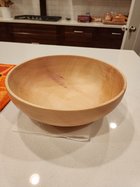I turned a bowl out of some green sycamore that ended up being about 11" wide and 4' tall. I decided I didn't want to wait a year for it to dry so I "finish" turned it from the get go kind of expecting it to blow up while drying. I did do a little bit of sanding on it while it was still in the chuck and actually put some tried and true original on it as well. Ten days later it has warped but not blown up. I quiet like the look of it still despite it being a bit oblong and know I could have done better with my sanding/finishing.
When you turn a green bowl just once and expect it to move when do you sand it? Do you do that while its green or do you wait until its dry and sand it on the bench? I don't have enough meat to true this bowl back up, the tenon or the rim. Jam chuck maybe?
I appreciate any advice.
This is right off the lathe. I'll have to take another picture tonight showing its new shape.

When you turn a green bowl just once and expect it to move when do you sand it? Do you do that while its green or do you wait until its dry and sand it on the bench? I don't have enough meat to true this bowl back up, the tenon or the rim. Jam chuck maybe?
I appreciate any advice.
This is right off the lathe. I'll have to take another picture tonight showing its new shape.

